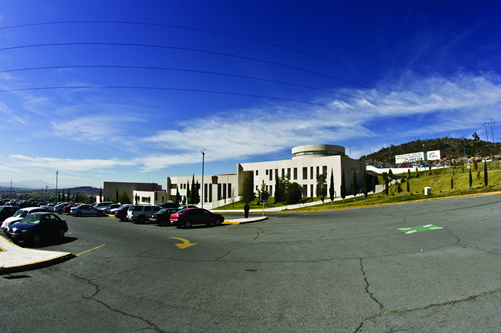Background
Institute of Social Sciences and Humanities

In 1996, as a requirement of the Ministry of Public Education, the Universidad Autónoma del Estado de Hidalgo requested that in its new organizational structure it should contemplate the creation of Institutes, organized internally by areas of knowledge. When Raúl Arroyo González was the director of the Institute of Social Sciences (ICSo.), a diagnosis was made of all the university entities that would later give rise to the Institute of Social Sciences and Humanities (ICSHu.) and a strategic planning exercise was carried out with the heads of the Schools, Research Centers, led by the Institute of Social Sciences; a strategic plan was made for the next ten years and based on this information, the guiding document was prepared where the goals to be achieved in the period from 1997 to 2006 were made explicit.
The aforementioned document takes into account the academic work of the Institute of Social Sciences (ICSo.), which offered Bachelor's Degrees in Law and Public Administration, which later changed its name to Bachelor's Degree in Political Science and Public Administration, this Institute gave rise to the Academic Areas of Law and Jurisprudence and Political Science and Public Administration; the School of Social Work (TS), only became an Academic Area, going from offering an educational program at the Technical level in Social Work to the Bachelor's Degree in Social Work; The Center for Population Studies (CEP), which offered the Regional Master's Program in Population Studies, which later changed its name to Master's in Population Studies; this Center would give rise to the Academic Area of Sociology and Demography; the Center for Studies on the State of Hidalgo (CEH), which gave rise to the Academic Area of History; the Center for Studies on the University (CESU), which offered the Specialization in Teaching and the Master's Program in Education; and the Academic Area of Educational Sciences was born.
Based on the human and technical resources available to the Self-Access Center of the UAEH, the creation of the Academic Area of Linguistics was proposed, however, with the approval by the University Council of the Bachelor's Degree Program in English Language Teaching, according to Act No. 202 dated May 13, 1999. When the program was born, what was proposed as the Area of Linguistics began to take shape, initially using the facilities formerly occupied by the Dentistry program in the Ciudad Universitaria, today Ciudad del Conocimiento, later occupying part of the towers of the Virtual University, today Torres de Rectoría, and it was not until 2002 that it was incorporated into the facilities of the ICSHu.
The Institute of Social Sciences and Humanities was born to the Institutional life, by agreement of the H. University Council, according to Act No. 218 dated July 5, 2001, with Mr. Alberto S. Jaén Olivas as director. However, the activities of the different Academic Areas, Educational Programs and Academic Bodies began to operate in an integrated manner, under the same direction and in the same campus spaces, until 2002, with Mr. Gerardo Martínez Martínez as director.
The DES of Social Sciences and Humanities, which is integrated by eight Academic Areas: Law and Jurisprudence; Political Sciences and Public Administration; History and Anthropology; Educational Sciences; Communication Sciences, Linguistics, Sociology and Demography; Social Work, in its beginnings, attended 21 educational programs: one associate professional, nine undergraduate, three specialty, five Master's and three Doctoral programs; it has had four directors: Lic. Alberto Jaén Olivas (1998-2002), Lic. Gerardo Martínez Martínez (2002-2005), M. D. Adolfo Pontigo Loyola (2005-2011) and Dr. D. Edmundo Hernández Hernández, who is the first director elected for a period of six years, based on the modifications approved in 2010 to the Organic Law (2011-2017).
Prior to this effort, the Social Sciences and Humanities had been characterized by an independent development, where the substantive functions had generated a diversity of conceptualizations of them, predominating a fragmented vision among the academic units that performed some function within the Social Sciences and Humanities, not only between those that performed Teaching and Research, that is, between Institutes and Research Centers, but this phenomenon occurred between the Institutes of Social Sciences, Administrative Accounting Sciences and the School of Social Work.
Emphasis was placed on professionalization, i.e., the production of graduates for professional practice, prioritizing careers in the areas of Law, Private Administration, Public Accounting, Public Administration and Social Work, which the labor market demanded, without taking into account the development of other social disciplines.
As a result of the academic work carried out in 1997, a document was prepared to propose the need to regroup the disciplines of Social Sciences and Humanities in a single Higher Education unit, with the possibility of expanding the educational offer with new degrees in these fields, resulting in the document "Program for the Improvement of the Faculty of the Institute of Social Sciences and Humanities".
As of 1997, this document became the guiding document for the actions undertaken with the purpose of integrating teaching, research and extension activities as a dynamic process. To achieve these objectives, an organizational structure is proposed, less bureaucratic and more horizontal, with strong interactions between the departments, their functions and the subjects responsible for the realization of academic work.
The document included the name of the position, its objective and main functions, making it clear that its level of generality favors the creative development of the person holding the position, as it does not establish any limitation for its effective performance.